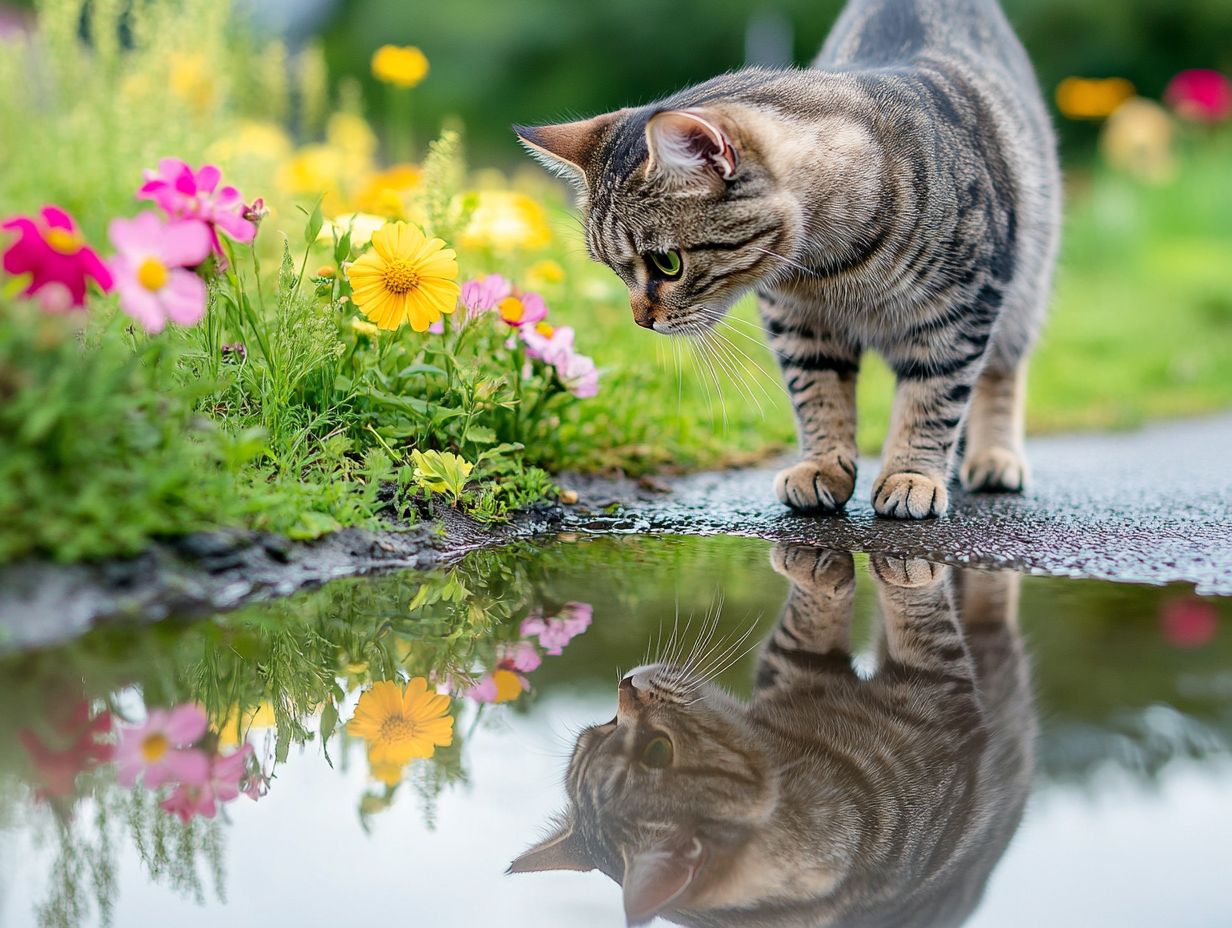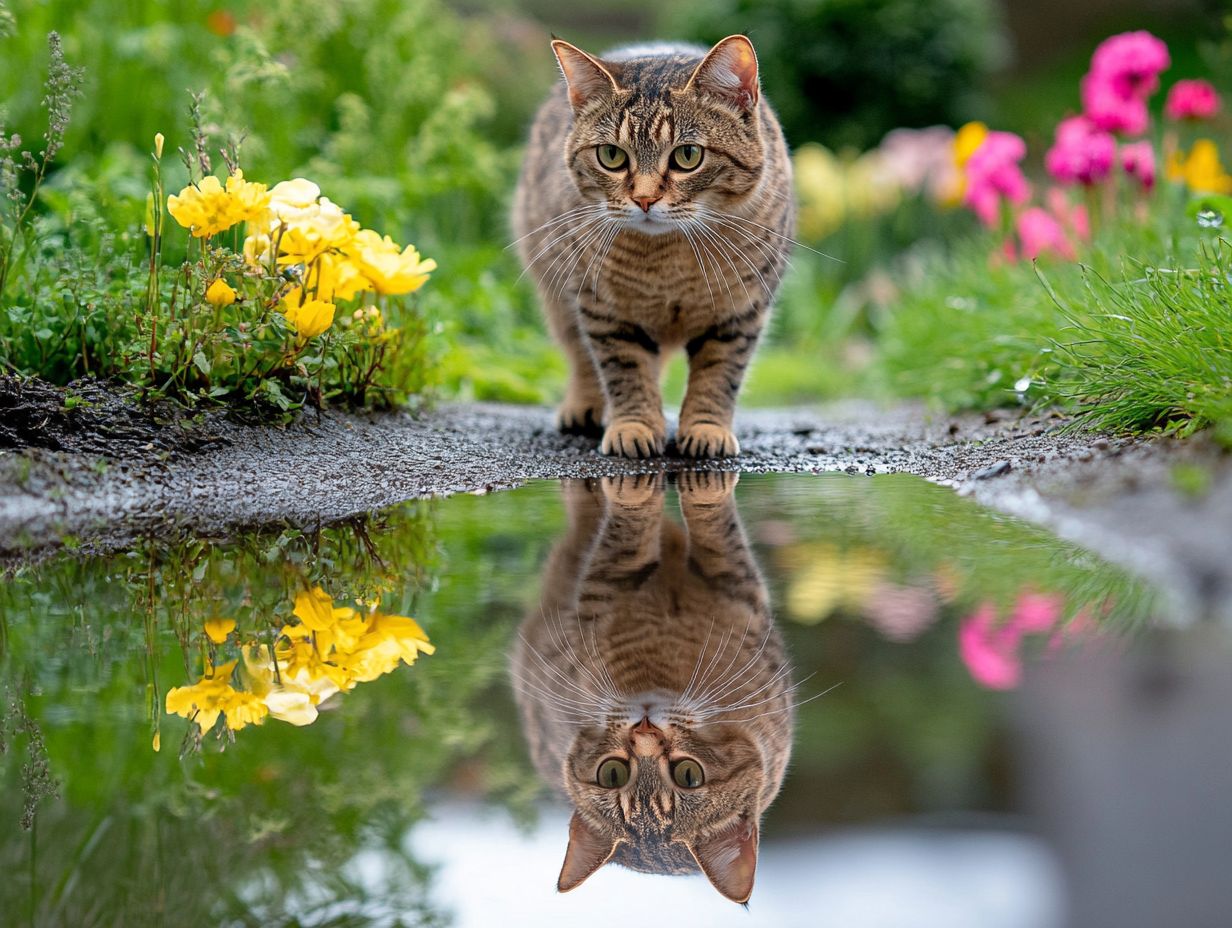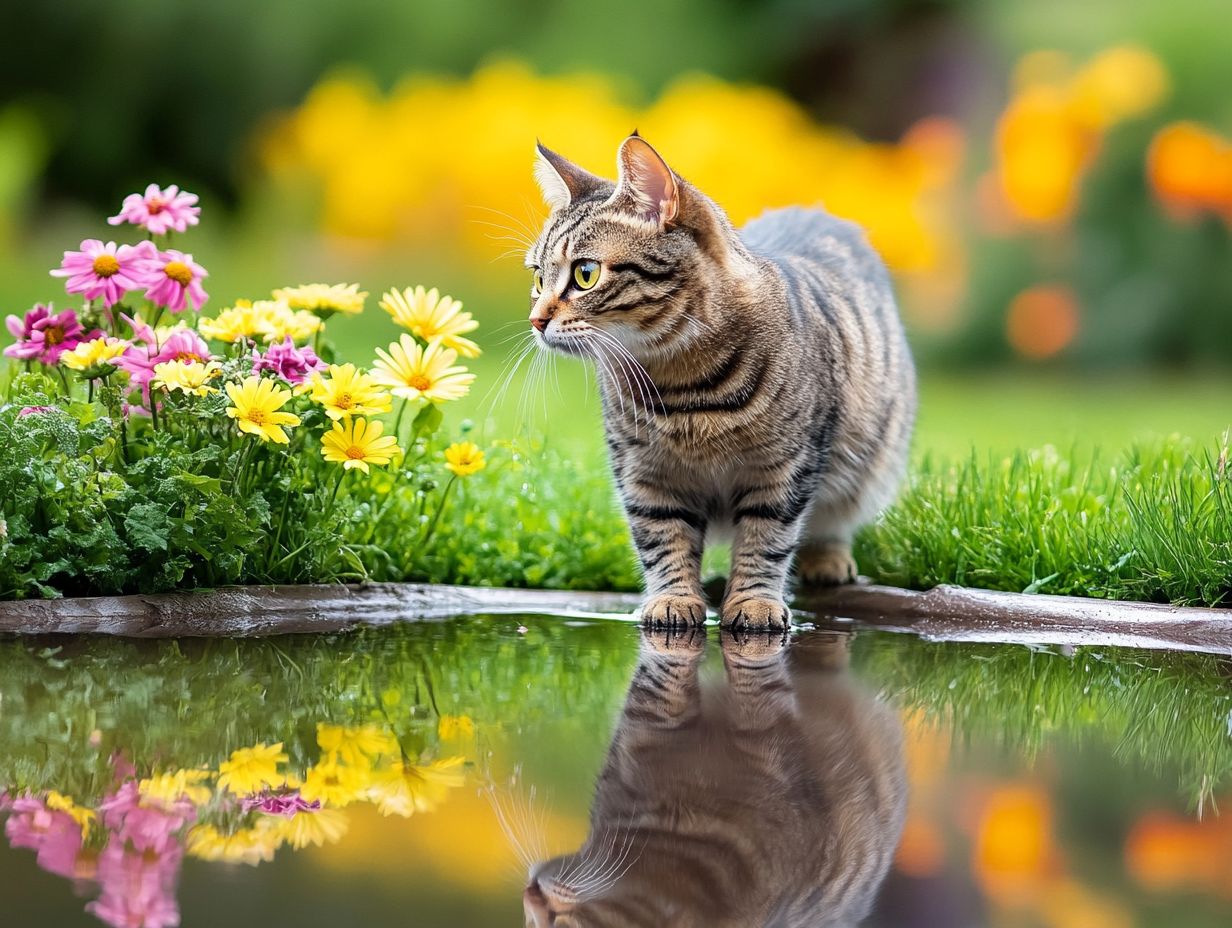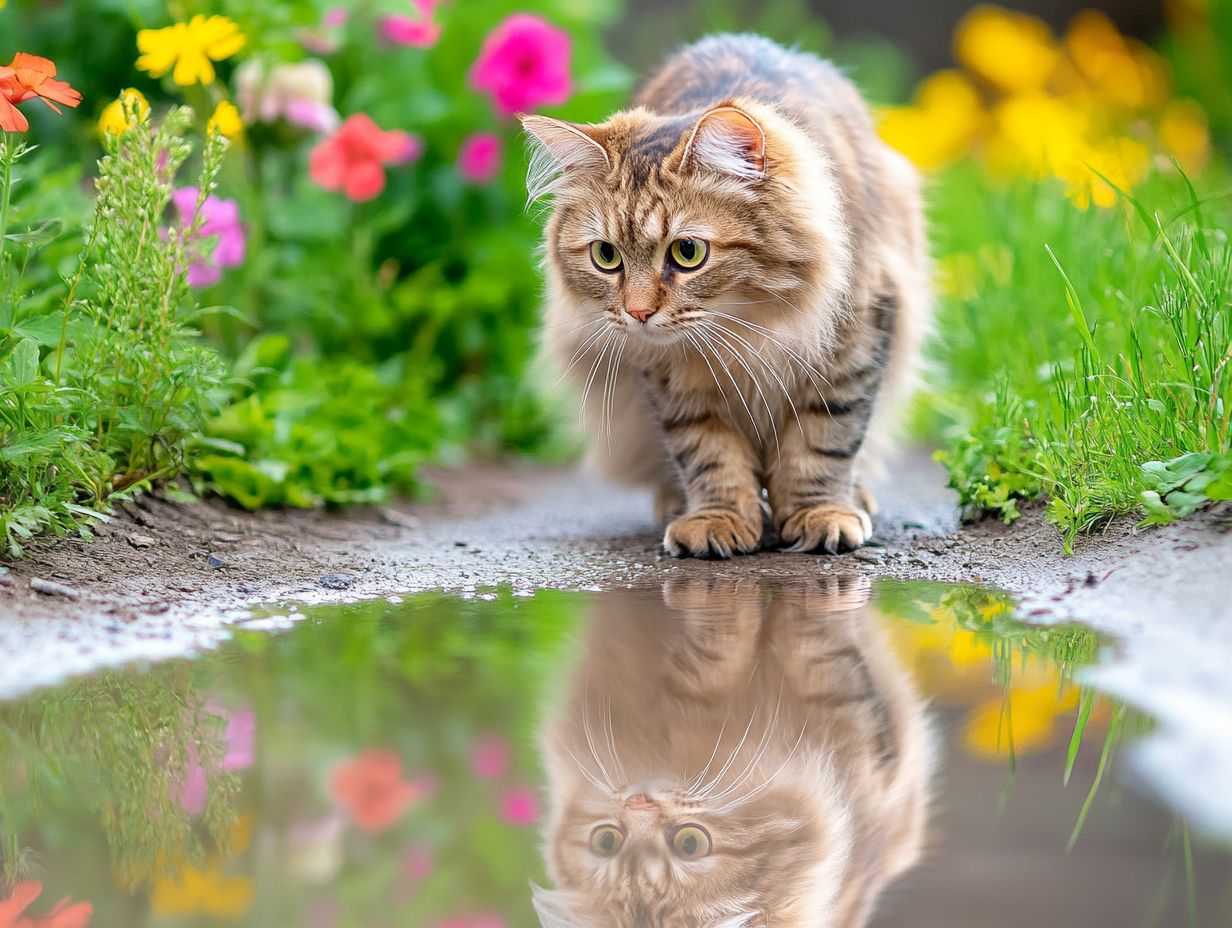Many cat owners wonder why their furry companions seem to have an aversion to water, a behavior often linked to their survival instincts. Understanding how a cat perceives water through its senses can provide valuable insights into their behavior.
From myths about their supposed hatred for it to the surprising truth about certain breeds that actually enjoy splashing around, the relationship between cats and water is more complex than you might think. Studies, such as those published in veterinary journals, indicate that individual experiences, along with genetic factors, play a crucial role in how cats react to water.
This article explores common misconceptions, the benefits and risks of introducing your cat to water, and tips for training them to swim safely, taking into consideration their unique personalities and experiences. We will also discuss how environmental factors, such as early experiences with water, influence a cat’s behavior.
Uncover the facts and enjoy a deeper understanding of your feline friend!
Key Takeaways:

Do Cats Hate Water?
Many cat owners believe that cats inherently dislike water, but this is not entirely accurate as there are several variables at play. While it is true that not all cats enjoy water, their aversion to it often relates to their individual personalities, past experiences with water, and the characteristics of specific breeds.
Although most cats may not enjoy swimming in deep water and might even appear fearful of it, certain breeds, such as the Turkish Van, actively enjoy water. This demonstrates that there is a spectrum of behaviors and feelings regarding this essential element. Moreover, environmental enrichment with water-related activities, like shallow pools, can enhance their comfort levels.
What Are The Common Misconceptions About Cats And Water?
Common misconceptions about cats and water often suggest that they dislike it, leading to a misunderstanding of their behavior around water sources. The reality, however, is more nuanced.
Many felines can tolerate water quite well, even if they don’t enjoy getting wet. This preference is partly due to their grooming habits; cats spend a significant amount of time meticulously grooming themselves, which reduces their need to seek out water for cleaning. Additionally, understanding feline body language can help owners gauge their cat’s comfort around water.
While some cats may have a clear aversion to swimming, others exhibit curiosity when presented with a running tap or a small puddle. Recognizing these behaviors helps debunk the myth that all cats are afraid of water and instead highlights the diverse personalities found within the feline world. It is important to note that these behaviors may vary significantly across different life stages, from kittens to seniors.
Can Cats Swim?
Cats are frequently considered non-swimmers; however, many felines possess an intrinsic ability to swim, although their experiences and behaviors regarding water can differ significantly. For instance, kittens may take to water differently compared to adults or senior cats, who may have developed specific aversions or affinities.
Why Do Cats Avoid Water?
Cats generally dislike water due to a combination of instinct, negative past experiences, and their sensitivity to the substance. This aversion can be traced back to their ancestry, as many wild cats inhabited regions where getting wet could be life-threatening.
If a cat has had a negative experience with water—such as being caught in a rainstorm or getting soaked during play—this fear can linger. Additionally, their sensitive fur and skin make them uncomfortable in water, leading them to prefer dry environments where they feel safer and more in control. Signs of stress or anxiety should be observed, and if they appear, owners should implement strategies to reduce these feelings during water exposure.
Are There Any Breeds Of Cats That Like Water?
While most cats tend to dislike water, certain breeds actually enjoy swimming and playing in it. According to the American Kennel Club, these breeds include the Turkish Van, Bengal, Maine Coon, Abyssinian, and American Shorthair.
The Turkish Van, often referred to as the “swimming cat,” is known for its affinity for water. Its water-resistant coat helps keep it warm in cold water, making it one of the few breeds that can swim comfortably, even over long distances.
Bengals, with their active nature, also enjoy water, likely due to their wild ancestry that involved exploring environments with streams and rivers. Maine Coons are a large breed characterized by their muscular physique and tufted ears; they are naturally curious and have a fondness for water, stemming from their history of hunting in wet areas.
Abyssinians are known for their playful and adventurous personalities, often reveling in water play. Lastly, American Shorthairs are fun-loving and friendly cats that are inquisitive and enjoy splashing and playing in water.
However, it’s essential to respect a cat’s comfort level and avoid forcing them into water, as this can lead to negative experiences. Instead, a proactive approach to introducing water from an early age can help mitigate aversion later in life.
Introducing Your Cat to Water
When introducing your cat to water, using positive reinforcement is crucial. Gradually expose your cat to water, rewarding them with treats and praise for calm behavior. You can start with small steps, such as allowing them to play with a damp cloth or gently introducing them to a shallow dish of water.
In multi-cat households, dynamics can influence attitudes toward water. If one cat exhibits curiosity or enjoyment, others may follow suit. Observing their interactions and providing safe environments for exploration is key.
When to Seek Professional Help
If your cat exhibits severe anxiety or distress around water, it may be best to consult a veterinarian or a certified animal behaviorist. They can provide tailored advice and strategies for addressing water-related behavior issues.
The Ongoing Journey of Understanding
As you navigate your cat’s relationship with water, remember that ongoing education is valuable. Seek additional resources, such as books or reputable websites, to deepen your understanding of feline behavior and enhance the human-cat bond.
What Are The Benefits Of Introducing Cats To Water?
Introducing cats to water offers several benefits, including improved grooming, increased physical exercise, and opportunities for enjoyable bonding activities between pets and their owners, potentially mitigating emotional trauma and enhancing socialization. According to the American Veterinary Medical Association, proper grooming is essential for a cat’s overall health.
1. Helps With Grooming

Water plays a significant role in a cat’s grooming routine, helping to maintain both hygiene and overall coat health. When used thoughtfully, bath time can become an enjoyable experience for both pets and their owners. Understanding feline cognition, it’s important to approach water introduction gradually, as cats perceive water differently based on their individual experiences.
Utilizing a gentle spray nozzle allows for better control of the water flow, making bath time more relaxing and less intimidating. Expert-recommended, high-quality pet shampoos designed for sensitive skin enhance coat cleanliness without causing irritation. Grooming can also be complemented by moisturizing conditioners that give the coat a healthy shine.
Regular baths are essential as they help reduce allergens and dander in the home, while also providing an opportunity for owners to bond with their pets, transforming hygiene routines into enjoyable activities rather than stressful ones. Observing your cat’s body language during bath time can provide insights on their comfort level and stress responses.
2. Promotes Exercise
Engaging cats in water activities can promote exercise, leading to improved physical health and overall wellness. This enjoyable form of play encourages them to move, leap, and swim, significantly enhancing their muscle tone and cardiovascular health. According to a study by the Journal of Feline Medicine and Surgery, interactive water play can foster both physical and mental stimulation.
By introducing various water-based games, such as floating toys or gentle splash pads, owners can stimulate their feline friends’ natural instincts while ensuring they remain active and energized. It’s important to consider that not all cats, especially certain breeds, will have the same affinity for water; understanding individual preferences can lead to more effective engagement.
The benefits of these aquatic exercises are numerous; they not only help maintain a healthy weight but also reduce the risk of obesity-related conditions. Additionally, interactive water activities can enhance a cat’s agility, flexibility, and coordination, contributing to a more balanced and engaging lifestyle.
3. Can Be A Fun Activity
Introducing cats to water can be a playful experience that entertains them while strengthening the bond between pet and owner. Engaging in water activities, such as gentle splashing in a shallow tub or enticing them with floating toys, can reveal the playful nature of these often misunderstood creatures. Using positive reinforcement techniques, like treats or praise, can further encourage positive interactions.
Cats may enjoy observing bubbles or fish-shaped toys as they float, providing both mental stimulation and physical exercise. By allowing pets to explore at their own pace, owners can foster trust and open up a new realm of joyful interaction, enhancing the emotional well-being of both the cat and the owner.
What Are The Risks Of Letting Cats Near Water?
Introducing cats to water has both advantages and disadvantages. The disadvantages include the risk of drowning and exposure to harmful chemicals. It’s crucial to assess risks and establish safe practices before any water introduction.
1. Drowning
Drowning poses a significant risk when allowing a cat access to water, even in relatively shallow environments. While cats are naturally agile and curious, they lack the same understanding of danger that humans possess. According to the Cat Behavior Associates, recognizing signs of panic in your cat can help prevent accidents.
Small puddles, bathtubs, and open bodies of water can present serious hazards, as an unexpected slip may trigger panic. To ensure safety around water, it is important to supervise your cat in water-prone areas. Additionally, building barriers such as gates or screens can help restrict access to dangerous zones.
Teaching cats to avoid water sources, along with providing secure enclosures, can significantly reduce the risk of accidental drowning and enhance their overall safety. If a cat has a history of anxiety around water, consider consulting a veterinarian or animal behaviorist for tailored guidance.
2. Exposure To Harmful Substances
Cats can suffer from exposure to harmful substances found in water, such as chlorine and other chemicals, which can negatively impact their health. Contaminated water sources can lead to issues beyond just being unpalatable, resulting in serious health effects including gastrointestinal problems, skin irritations, and even long-term organ damage. Always ensure that water sources are safe and clean.
Drinking unsafe water can weaken their immune systems and overall health, making it essential to provide them with treated, clean water. Responsible pet owners should consistently monitor the quality of water sources to ensure their cats thrive in a safe environment, free from the potentially harmful elements present in untreated water.
How To Introduce Cats To Water?
When introducing cats to water, consider their developmental stages. Kittens may be more curious but less coordinated, while senior cats may have physical limitations affecting their interaction with water. A gradual, positive approach can ensure a successful experience for all ages.
Provide a list of safe water-related activities that stimulate a cat mentally and physically, such as water fountains for drinking or shallow water play with floating toys. Understanding feline body language during introduction is crucial; recognize signs of stress or enjoyment and adjust accordingly.
Additionally, address common myths about cats and water, such as “cats hate water,” and provide factual counterpoints, including breeds known for enjoying water, like the Turkish Van.
Finally, consider ethical implications of forcing a cat into water situations, and always respect individual boundaries. Monitoring for signs of anxiety during introduction is key, and proactive strategies can help create a calm environment. Ruling out any medical issues prior to introducing water is also essential.
Cats should be gradually introduced to water to ensure their safety and to provide a positive experience that does not reinforce any fears they may have. This includes using life jackets and ensuring they are not exposed to harmful substances like chlorine. Studies have shown that a calm environment and gradual exposure can significantly reduce anxiety in cats during such introductions.
1. Start Slowly

Introducing cats to water should be done slowly to build their confidence and reduce anxiety. This process requires a thoughtful approach, where the owner carefully observes the cat’s reactions and adjusts training techniques as needed. Environmental factors, like noise or the presence of other pets, can also influence a cat’s comfort level.
By gradually introducing water in a controlled environment, such as a shallow basin, the cat can acclimate to the sensation without feeling overwhelmed. Incorporating positive reinforcement, like treats or gentle praise, helps create a favorable association with the experience. Cats feel more secure when they are given the space to explore at their own pace, respecting their emotional state.
Patience is essential; allowing the cat to explore at their own pace ensures that their comfort level gradually increases, making the journey more enjoyable for both the pet and the owner. It’s important to understand that different life stages—kittens, adults, and seniors—may affect a cat’s responses to water, with older cats potentially showing different comfort levels due to physical limitations.
2. Use Positive Reinforcement
Using positive reinforcement methods enhances the experience of introducing cats to water, making it more enjoyable for them. By employing various motivators such as food rewards, verbal encouragement, and play, owners can create positive associations that foster exploration and adjustment. The scientific basis for positive reinforcement lies in its ability to encourage desired behaviors without the use of punishment, which can have long-term benefits on feline behavior.
For instance, offering a small treat immediately after a cat shows interest—like pawing at the water—reinforces positive behavior. Verbal reinforcement is also valuable; using an upbeat tone can help instill confidence in the cat during their initial exposure to water. Playing with floating objects can serve as a distraction, encouraging exploration while alleviating any stress associated with water. This personalized approach not only facilitates a smoother introduction but also strengthens the bond between pet and owner.
3. Be Patient And Consistent
Introducing cats to water requires patience and consistency, as these qualities help create a predictable environment that fosters trust between the animal and its owner. A gradual approach is essential, as cats are often tentative when faced with new experiences, particularly those involving water. Observing feline body language—such as flattened ears or a twitching tail—can provide insight into their comfort level during the process.
By slowly introducing them to this element, you can provide a safe and secure environment, which helps build their confidence and encourages curiosity. This method can transform what might be a stressful experience into a playful and inquisitive one. Symptoms of anxiety, such as hiding or excessive grooming, may indicate discomfort with water and should be addressed promptly.
Utilizing positive reinforcement techniques, such as rewarding them with treats or gentle praise, consistently reinforces desirable behavior, making the experience more enjoyable for the cat. The introduction should be conducted at a pace that is comfortable for each individual cat, as success is determined more by their willingness than by the speed of the process. In multi-cat households, managing dynamics is also crucial to ensure each cat feels secure during the water introduction.
Can Cats Be Trained To Swim?
Cats can learn to swim, but it is important to use careful methods to ensure their safety and comfort throughout the process. Consulting a veterinarian beforehand to rule out any medical issues that may affect a cat’s comfort with water is advisable.
1. Use A Life Jacket
Using a life jacket specifically designed for cats can provide an added layer of safety during swim training, helping them feel more secure in the water. This accessory not only acts as a buoyancy aid but also enhances comfort, making the overall experience less intimidating for your feline friend. For more information, check out Can Cats Swim and Do Cats Hate Water? Cat Myths Busted.
When properly fitted, the life jacket allows for unrestricted movement, promoting a more natural swimming action. This is crucial as it encourages the cat to acclimate to the water without unnecessary stress. Additionally, having a life jacket can help mitigate the risk of accidents, ensuring that each training session prioritizes your pet’s well-being. Ethical considerations should guide the use of such gear; forcing a cat into water situations can harm their emotional state.
Investing in this safety gear is essential for a positive and enjoyable introduction to swimming. Providing opportunities for early socialization and positive associations with water from a young age can prepare your cat for future exposure.
2. Start In Shallow Water
Beginning swim training in shallow water helps cats acclimate to the experience without overwhelming them. This initial exposure is crucial, as it allows them to learn in a safe environment that builds their confidence and reduces anxiety about swimming. Incorporating floating toys and obstacles can further stimulate curiosity and make the learning environment engaging.
Gradually introducing swimming in this manner ensures their safety and enables them to acclimate without fear. Allowing them to explore their surroundings at a shallow depth, where they can develop necessary skills at their own pace, not only makes them more comfortable but also prepares them for deeper water experiences in the future. Cats may feel more secure when allowed to approach water at their own pace, as this respects their natural instincts and emotional state.
3. Gradually Increase Water Depth
Gradually increasing water depth during training sessions helps cats adapt to deeper water without overwhelming them. This approach reduces anxiety at greater depths and enhances the cat’s comfort and skills with each successive session. Individual cats may have unique responses to water based on their breed, genetic disposition, or prior experiences with water.
By allowing them time to explore each level, caregivers can foster a sense of security, which is crucial for any feline learning process. It is important to note that this process can take time; rushing it is often counterproductive. Understanding the body language of cats, such as tail position or vocalizations, can provide insights into their comfort levels during these sessions.
This method not only improves the cats’ physical capabilities but also builds their comfort with the training, ultimately creating a more effective and enjoyable experience. Cats are naturally equipped to swim, as supported by research from [reputable source]. This foundation leads to more successful sessions in deeper water in the future.
Frequently Asked Questions

Can cats swim?
Yes, cats can swim. Although many people believe that cats hate water and cannot swim, this is actually a myth. While not all cats enjoy being in water, they are able to swim if necessary. Introducing water to kittens early can help prevent fear later in life.
Do cats hate water?
Not all cats hate water. Some cats may be afraid of water or simply dislike it, but there are also many cats that enjoy playing with water or even swimming. Positive reinforcement training techniques can encourage these behaviors.
Why do people think cats hate water?
Cats are often associated with hating water because they groom themselves regularly and are very clean animals. However, this does not mean that they are afraid of water or cannot swim. Many myths exist about cats and water, often stemming from misunderstandings about their behavior.
Can all cat breeds swim?
Yes, all cat breeds have the physical ability to swim. However, some breeds, such as the Bengal or Turkish Van, are known to enjoy water more than others. Each cat’s comfort level with water may vary.
How can I teach my cat to swim?
You cannot teach a cat to swim, as they instinctively know how to do it. However, you can introduce your cat to water gradually and provide a safe environment for them to explore it if they are interested. Using floating toys can enhance the experience.
Are there any dangers associated with cats and water?
Yes, there are certain dangers associated with cats and water, such as the risk of drowning or exposure to chemicals in swimming pools. It is important to always supervise your cat around water and provide them with a safe way to enter and exit the water. Recognizing signs of stress during water exposure is vital to ensure the cat’s emotional well-being is prioritized.
What if my cat is anxious about water?
Common fears or anxieties cats may have about water can stem from past experiences. It may be beneficial to implement gradual exposure techniques and consider seeking professional help if anxiety persists. Veterinary advice is recommended for behavioral issues related to water anxiety.
How can positive swimming experiences strengthen the bond with my cat?
Positive swimming experiences can strengthen the bond between humans and cats, making training sessions a mutual learning experience. Respecting their individual comfort levels and providing a calm environment can enhance this relationship.